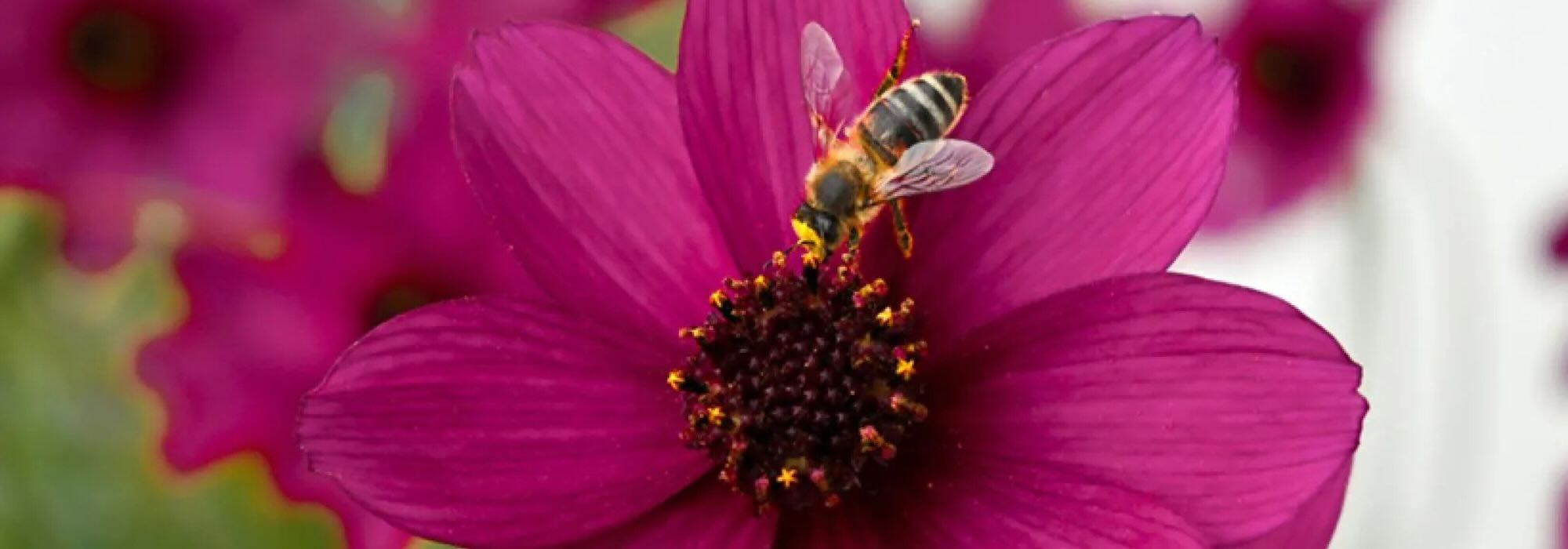
Annual Melliferous Plants: Flowers to Attract Pollinators
Selection and advice
Contents
Flowers are not just there to beautify our gardens: they also play a vital role in preserving biodiversity. By sowing or planting melliferous annuals, you can attract a wide variety of pollinators, such as bees, butterflies, and bumblebees, while enjoying a vibrant, flower-filled space throughout the growing season. These plants, easy to grow and often highly decorative, provide a valuable source of nectar and pollen for beneficial insects. In this article, discover why melliferous annuals deserve a prime spot in your garden, and which species to choose to combine beauty, simplicity, and ecology.
Melliferous annual plants: what are they?
When we talk about melliferous plants, we’re simply referring to plants rich in nectar and pollen, which bring joy to bees, butterflies, bumblebees and many other pollinators. They play a super important role in nature: they feed insects and, in return, these little creatures ensure the pollination of our vegetables, fruits and flowers. It’s a true exchange of favours!
Among them, we distinguish nectariferous plants, meaning those that produce abundant nectar, the preferred food of many pollinating insects. All nectariferous plants are melliferous, but not all melliferous plants are necessarily nectariferous: some mainly produce pollen. The ideal is to have a mix of both in the garden to feed all these little helpers.
Annuals, on the other hand, are plants that live, flower and die in a single season. They grow quickly, often flower very abundantly, then complete their cycle before winter. Unlike perennial plants that return each year, annuals need to be resown or replanted every spring (or let nature take its course if they self-seed). We sometimes group tender perennials with annuals because they disappear with the cold.
In short, they’re precious allies for all gardeners, beginners or experienced, who want to give biodiversity a helping hand… while enjoying a garden buzzing with life!
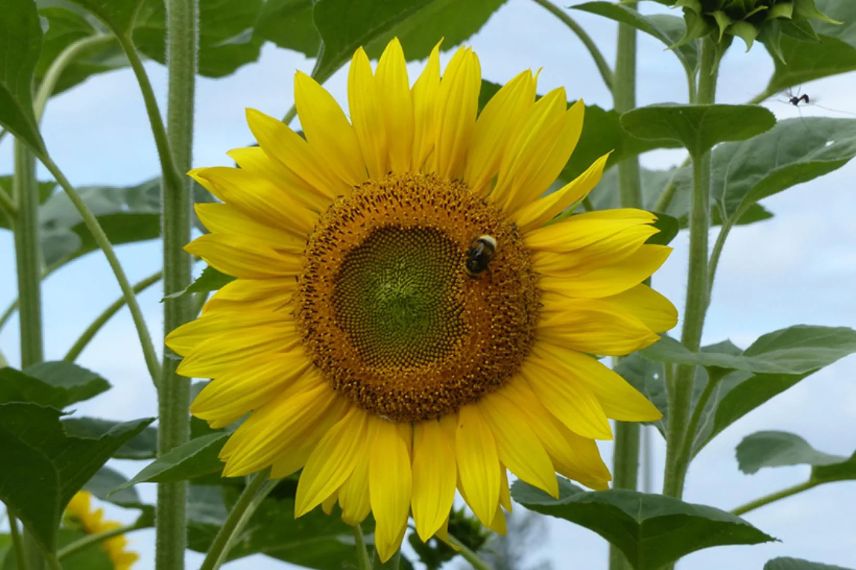
Sunflower is a highly melliferous annual, useful for structuring flower beds
Read also
10 Easy Annual Flowers to SowThe Key Role of Pollinators in Our Gardens
Pollinators are the unsung heroes of our gardens. We see them flitting from flower to flower, but their role is far more crucial than we might think! Their mission? To transfer pollen from one flower to another, enabling fertilisation and thus the production of fruits, vegetables, seeds, and more.
Who are these invaluable allies?
- Bees, of course—both domestic and wild—are the stars of pollination.
- Bumblebees, plumper in build, work even in cool or overcast weather.
- Butterflies add a touch of magic to the garden while pollinating.
- Hoverflies, often mistaken for bees, are also superb pollinators.
- Even some beetles and bats join the effort (though bats are mainly in tropical zones—still, we salute them!).
Why are they vital for the garden?
- Without them, many crops wouldn’t bear fruit: tomatoes, strawberries, courgettes, apple trees… the list goes on!
- They maintain ecosystem balance by enabling the natural reproduction of countless plants.
- They foster plant diversity, making gardens more resilient against diseases and pests.
But here’s the catch: pollinators are under threat due to pesticides, habitat loss, and climate change… This is where gardeners can make a difference in their own green spaces.
By planting melliferous annuals, gardeners provide a floral buffet and a true nectar refugium. As a bonus, the garden becomes alive with colour and butterflies.
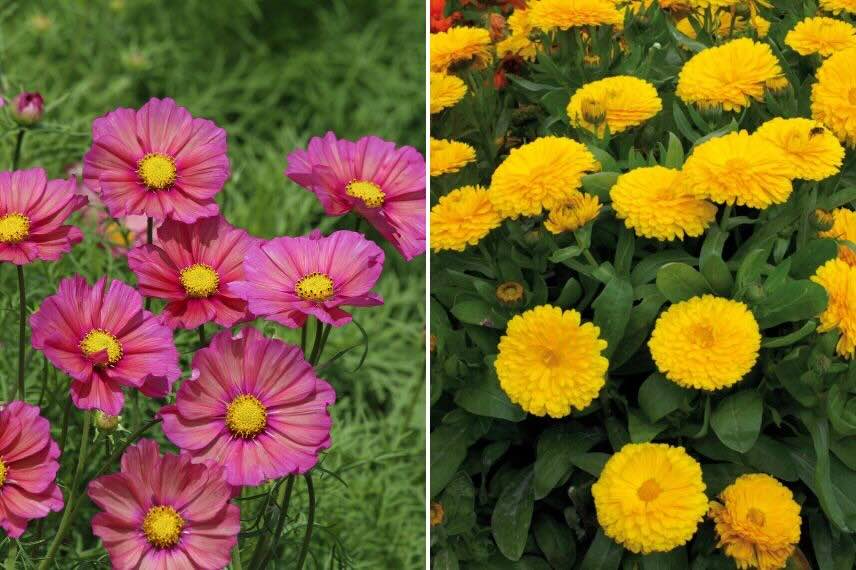
Cosmos and Calendula, two more champion melliferous and nectariferous plants
Top 7 Easy-to-Grow Melliferous Annual Plants
Cosmos, Light and Cheerful
The cosmos is an essential annual plant for flowering gardens. It produces an abundance of light, cheerful flowers on very fine foliage, blooming tirelessly from June until the first frosts. It attracts bees, butterflies and hoverflies alike. Cosmos thrive in full sun, tolerate poor soil and can reach up to 1.20 metres in height depending on the variety.
Pot Marigold or Calendula, Useful in the Vegetable Garden
The pot marigold, or calendula, flowers continuously from spring to autumn and thrives equally well in full sun or partial shade. It remains fairly compact, between 30 and 60 cm tall, and produces abundant nectar. As a bonus, its petals are edible and its roots help repel certain pests in the vegetable garden.
The Essential Sunflower
The tall, slender stems and golden flowers of the sunflower make a striking feature in any garden corner, vegetable patch or at the back of a flower bed. The sunflower blooms from July to September and attracts a great number of pollinating insects. The seeds it produces are also a valuable food source for birds at the end of the season. It loves sunny positions and can easily exceed two metres in height for the tallest varieties.
Pretty Borage
Borage is a charming plant, with bright blue star-shaped flowers that are very rich in nectar. It attracts many bees, flowers from May to September and thrives equally well in sun or partial shade. It grows 40 to 60 cm tall and has the advantage of self-seeding. The flowers are also edible, making lovely decorations for salads.
Ornamental and Vigorous Phacelia
Phacelia, with its pretty mauve flowers and rapid flowering, is one of the best plants for attracting bees. It blooms in summer, from June to August, and thrives in full sun. As well as being highly melliferous, it has the ability to improve the soil, making it an excellent plant to sow as green manure.
Charming Love-in-a-Mist
Nigella damascena is a delicate annual with very fine foliage and beautiful flowers followed by ornamental seed pods. Its sky-blue or white flowers bring a poetic touch to the garden between May and July. It attracts pollinators while being decorative, and its black seeds, once ripe, can be harvested for culinary use. It is easy to grow, thrives in sun and self-seeds naturally.
Floriferous and Cheerful Zinnia
Finally, the zinnia is a very colourful plant that flowers for a long time, from July until the first frosts. It loves sun and can grow up to 90 cm tall for the tallest varieties. Butterflies adore it. There is a wide variety of forms and colours, making it a beautiful bedding plant as well as an excellent cut flower for bouquets.
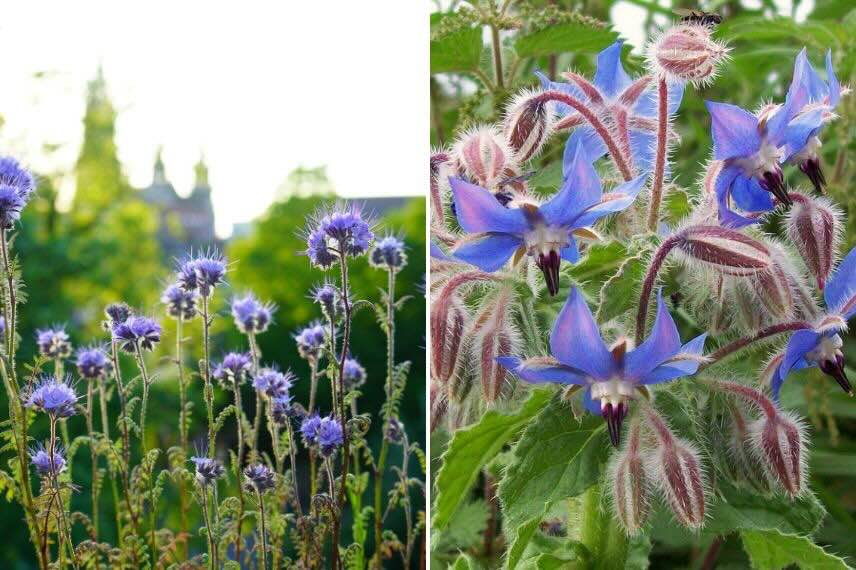
Phacelia and borage have a very rustic charm and delight pollinators
Incorporating melliferous annuals into the garden or balcony
A prime spot in the garden
Melliferous annuals easily find their place in all types of gardens. They can be sown along borders, in flower beds or even directly between vegetable rows in the kitchen garden. Certain species, such as marigolds or borage, have a dual benefit: in addition to attracting pollinators, they repel certain unwanted insects, providing natural protection for crops. Sunflowers, with their tall stature, can also serve as visual markers and structure the space by creating green screens or light hedges.
On a balcony or terrace, a potted oasis
Even with limited space, it’s entirely possible to attract pollinators. In pots or planters, melliferous annuals thrive beautifully, provided they have good sun exposure and well-drained soil. Cosmos, zinnias and marigolds are particularly well-suited to this type of cultivation. They offer abundant flowering and attract bees and butterflies, even in urban areas. A flower-filled balcony then becomes a precious oasis for pollinators.
Seed mixes: a simple and effective solution
For gardeners looking for quick, lush and varied results, melliferous seed mixes are an excellent option. These ready-to-sow packets contain an assortment of flowers that complement each other in terms of flowering periods and appeal to insects. They make it easy to create a flower-filled area in the garden while ensuring interesting plant diversity.
Ensuring staggered flowering
To nourish pollinators over a long period, it’s advisable to choose species that flower at different times or to sow several times during spring. This staggered approach ensures continuous flowering from spring until the first frosts. A diversity of shapes and colours also attracts a wider variety of insects, further enriching the garden or balcony ecosystem.
Letting some flowers go to seed
At the end of the season, it can be interesting to let some flowers go to seed. Certain annuals, such as love-in-a-mist or borage, self-seed naturally from year to year if the soil isn’t too disturbed. This allows the same flowers to return the following year without needing to replant them. It’s also a lovely way to let nature take its course and encourage a more self-sufficient garden.
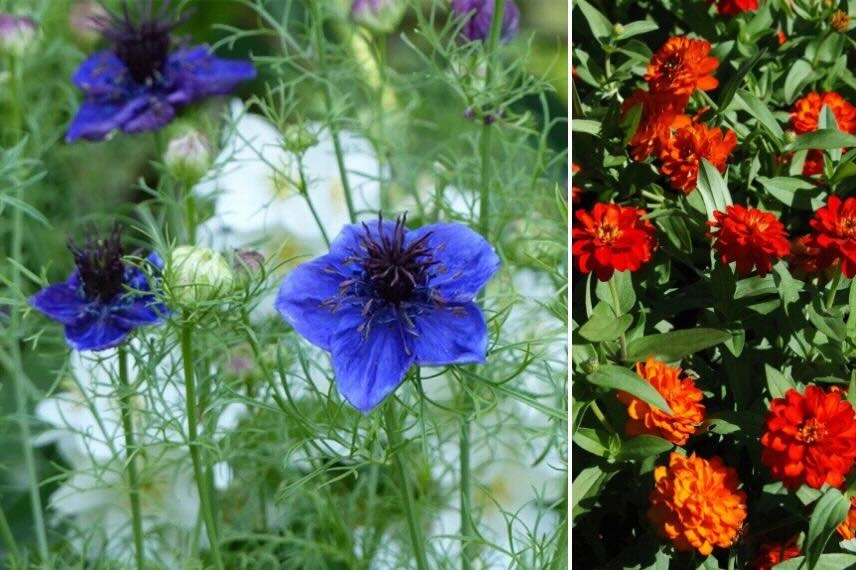
Love-in-a-mist and Zinnia. Love-in-a-mist self-seeds in soil that isn’t too heavy
- Subscribe!
- Contents
































Comments